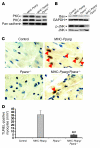PPARγ-induced cardiolipotoxicity in mice is ameliorated by PPARα deficiency despite increases in fatty acid oxidation
- PMID: 20852389
- PMCID: PMC2947216
- DOI: 10.1172/JCI40905
PPARγ-induced cardiolipotoxicity in mice is ameliorated by PPARα deficiency despite increases in fatty acid oxidation
Erratum in
- J Clin Invest. 2010 Dec 1;120(12):4583
Abstract
Excess lipid accumulation in the heart is associated with decreased cardiac function in humans and in animal models. The reasons are unclear, but this is generally believed to result from either toxic effects of intracellular lipids or excessive fatty acid oxidation (FAO). PPARγ expression is increased in the hearts of humans with metabolic syndrome, and use of PPARγ agonists is associated with heart failure. Here, mice with dilated cardiomyopathy due to cardiomyocyte PPARγ overexpression were crossed with PPARα-deficient mice. Surprisingly, this cross led to enhanced expression of several PPAR-regulated genes that mediate fatty acid (FA) uptake/oxidation and triacylglycerol (TAG) synthesis. Although FA oxidation and TAG droplet size were increased, heart function was preserved and survival improved. There was no marked decrease in cardiac levels of triglyceride or the potentially toxic lipids diacylglycerol (DAG) and ceramide. However, long-chain FA coenzyme A (LCCoA) levels were increased, and acylcarnitine content was decreased. Activation of PKCα and PKCδ, apoptosis, ROS levels, and evidence of endoplasmic reticulum stress were also reduced. Thus, partitioning of lipid to storage and oxidation can reverse cardiolipotoxicity despite increased DAG and ceramide levels, suggesting a role for other toxic intermediates such as acylcarnitines in the toxic effects of lipid accumulation in the heart.
Figures









Comment in
-
Lipotoxicity and the development of heart failure: moving from mouse to man.Cell Metab. 2010 Dec 1;12(6):555-6. doi: 10.1016/j.cmet.2010.11.016. Cell Metab. 2010. PMID: 21109186 Free PMC article.
Similar articles
-
Mitochondrial remodeling in mice with cardiomyocyte-specific lipid overload.J Mol Cell Cardiol. 2015 Feb;79:275-83. doi: 10.1016/j.yjmcc.2014.12.001. Epub 2014 Dec 9. J Mol Cell Cardiol. 2015. PMID: 25497302 Free PMC article.
-
Cardiac peroxisome proliferator-activated receptor-alpha activation causes increased fatty acid oxidation, reducing efficiency and post-ischaemic functional loss.Cardiovasc Res. 2009 Aug 1;83(3):519-26. doi: 10.1093/cvr/cvp132. Epub 2009 Apr 27. Cardiovasc Res. 2009. PMID: 19398469
-
Metabolic impairment in response to early induction of C/EBPβ leads to compromised cardiac function during pathological hypertrophy.J Mol Cell Cardiol. 2020 Feb;139:148-163. doi: 10.1016/j.yjmcc.2020.01.004. Epub 2020 Jan 17. J Mol Cell Cardiol. 2020. PMID: 31958467
-
Novel approach to treat insulin resistance, type 2 diabetes, and the metabolic syndrome: simultaneous activation of PPARalpha, PPARgamma, and PPARdelta.Curr Diabetes Rev. 2005 Aug;1(3):299-307. doi: 10.2174/157339905774574365. Curr Diabetes Rev. 2005. PMID: 18220606 Review.
-
The metabolic syndrome and the hepatic fatty acid drainage hypothesis.Biochimie. 2005 Jan;87(1):15-20. doi: 10.1016/j.biochi.2004.11.011. Biochimie. 2005. PMID: 15733731 Review.
Cited by
-
The relative contribution of paracine effect versus direct differentiation on adipose-derived stem cell transplantation mediated cardiac repair.PLoS One. 2013;8(3):e59020. doi: 10.1371/journal.pone.0059020. Epub 2013 Mar 19. PLoS One. 2013. PMID: 23527076 Free PMC article.
-
Lipid metabolism and toxicity in the heart.Cell Metab. 2012 Jun 6;15(6):805-12. doi: 10.1016/j.cmet.2012.04.006. Cell Metab. 2012. PMID: 22682221 Free PMC article.
-
Effects of PPARs agonists on cardiac metabolism in littermate and cardiomyocyte-specific PPAR-γ-knockout (CM-PGKO) mice.PLoS One. 2012;7(4):e35999. doi: 10.1371/journal.pone.0035999. Epub 2012 Apr 26. PLoS One. 2012. PMID: 22563432 Free PMC article.
-
Contribution of Impaired Insulin Signaling to the Pathogenesis of Diabetic Cardiomyopathy.Int J Mol Sci. 2019 Jun 11;20(11):2833. doi: 10.3390/ijms20112833. Int J Mol Sci. 2019. PMID: 31212580 Free PMC article. Review.
-
Myocardial ATGL overexpression decreases the reliance on fatty acid oxidation and protects against pressure overload-induced cardiac dysfunction.Mol Cell Biol. 2012 Feb;32(4):740-50. doi: 10.1128/MCB.06470-11. Epub 2011 Dec 12. Mol Cell Biol. 2012. PMID: 22158969 Free PMC article.
References
Publication types
MeSH terms
Substances
Grants and funding
LinkOut - more resources
Full Text Sources
Molecular Biology Databases

